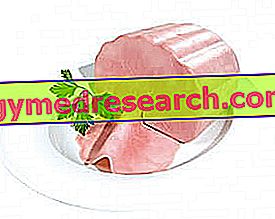Definition and uses in the kitchen
Flavor enhancers are additives, or substances used in the food industry to improve the characteristics of finished products; the functions of food additives are numerous (conservation, dye, thickener, etc.) but flavor enhancers are added with the sole aim of optimizing or enhancing the flavor of food.

The updated legislation allows the addition of the following flavor enhancers:
glutamates
- E620 Glutamic acid
- E621 Monosodium glutamate
- E622 Monopotassium glutamate
- E623 Calcium diglutamate
- E624 Monoammone glutamate
- E625 Magnesium diglutamate
- E626 Guanylic acid
- E627 Disodium guanylate - Sodium guanylate
- E628 Dipotassium guanilate
- E629 Calcium guanylate
inosinates
- E630 Inosinic acid
- E631 Disodium inosinate
- E632 Dipotassium inosinate
- E633 Calcium inosinate
- E634 Calcium 5'-ribonucleotides
- E635 Disodium 5'-ribonucleotides
- E636 Maltolo
- E637 Ethylmaltol
- E640 Glycine and sodium salt of glycine
The most used flavor enhancers are the E620 and the E640 ; they are able to reproduce the taste of meat, therefore, their addition in soups, sauces and ready meals after industrial cooking has become a common practice.
Flavor enhancers Glutamates
The glutamate flavor enhancers are naturally present in food proteins in the form of glutamic acid; the foods that contain greater quantities are: poultry, fish, crabs, some cheeses, mushrooms, legumes and some vegetables.
Excessive doses of glutamic acid and monosodium glutamate can inhibit the excitability threshold of neurons, causing alterations in the parasympathetic system that lead to the so-called "Chinese restaurant syndrome", whose most frequent and important symptoms are: nausea, vomiting, diarrhea, cramps abdominals and headaches. We also remember that there is an INTOLERANCE (or hypersensitivity) to feed towards these flavor enhancers, easily recognizable by the appearance of intoxication symptoms even after the ingestion of small doses of glutamic acid.
E622, ingested in excessive doses, originates only gastro-enteric disorders whereas E623, in sensitive people, can also trigger severe asthma attacks; E624 is characterized by high toxicity and is therefore totally excluded from the infant's diet. The E625 appears to be simply laxative, while the E626-E629 group has moderate toxicity.
Flavorless flavor enhancers
The flavor enhancers from E630 to E633 are added especially to seasoned foods and their excess food seems to facilitate the onset of gout; E634 and E635 are added in good quantity in French fries in bags, can induce asthma and hyperactivity, and in some foreign countries their use is FORBIDDEN.
E636 and E637 are substances that enhance the aromas of packaged products and are also found naturally in toasted foods. Their synthesis takes place through the degradation of cellulose and starch but, as they do not yet have sufficient data describing their toxicity, their use is prohibited in Europe.
E640 is added to foods containing saccharin and has a slight toxicity.
Flavor enhancers are food additives that alter the natural palatability of foods and, although abuse can trigger generally negligible side effects, their addition to foods has the sole objective of increasing commercial sales (for the benefit of industries) and not confers no health benefit to the final consumer.



